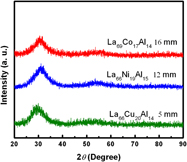Article contents
The effect of various transition metals on glass formation in ternary La-TM-Al (TM = Co, Ni, Cu) alloys
Published online by Cambridge University Press: 01 April 2011
Abstract

The optimum glass formers in ternary La-TM-Al (TM = Co, Ni, Cu) alloys were pinpointed at alloys La69Co17Al14, La66Ni19Al15, and La66Cu20Al14, exhibiting critical sizes for full glass formation of 16, 12, and 5 mm, respectively. Cobalt is found to be the most favorable element for glass formation in La-based alloys. The optimum alloys in La-TM-Al show close composition but significantly different glass-forming ability (GFA). The mechanism of distinct effect of TM elements remains unclear, even discussed based on current GFA-related criteria and indicators.
- Type
- Articles
- Information
- Copyright
- Copyright © Materials Research Society 2011
References
REFERENCES
- 4
- Cited by




